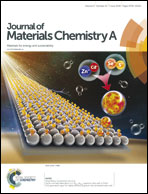Environmentally friendly synthesis of flexible MOFs M(NA)2 (M = Zn, Co, Cu, Cd) with large and regenerable ammonia capacity†
Abstract
Two environmentally friendly and efficient synthesis methods, NH3-assisted synthesis and solvent-evaporated conversion, have been developed for the synthesis of a series of M(NA)2 (M = Zn, Co, Cu, Cd; NA = nicotinate) flexible MOFs. The two-dimensional M(NA)2 (M = Zn, Co) and three-dimensional M(NA)2 (M = Cu, Cd) materials exhibit peculiar structural transformation. These frameworks can be obtained from dehydration of M(NA)2(H2O)4 (M = Zn, Co, Cu, Cd) which are zero-dimensional supramolecular structures. Interestingly, the structural transformation of M(NA)2 (M = Zn, Co, Cd) is reversible after liquid water adsorption. Due to the flexible structure of these MOFs, they exhibit abnormal NH3 adsorption properties. The two-dimensional Zn(NA)2 shows a gate-opening behavior for NH3 adsorption. Its layers opened at a pressure of 0.22 bar in the first cycle, resulting in a two-step NH3 uptake with a capacity of 10.2 mmol g−1 at 1 bar. The gate-opening pressure shifted to a lower value with cycles. Co(NA)2 has a huge NH3 uptake of 17.5 mmol g−1, which is top-ranking among the reported values. For the NH3 adsorption over Cu(NA)2 and Cd(NA)2, the adsorption rates increase and adsorption equilibrium is achieved faster after three cycles. Their maximum capacity at 1 bar is 13.4 and 6 mmol g−1, respectively. More importantly, all MOFs can be regenerated under vacuum and heating conditions of 150 °C for 70 min, and they all retained the capacity. The advantages of environmentally friendly synthesis, large adsorption capacity, and regenerable properties indicate that M(NA)2 (M = Zn, Co, Cu) are promising candidates for NH3 adsorption.



 Please wait while we load your content...
Please wait while we load your content...